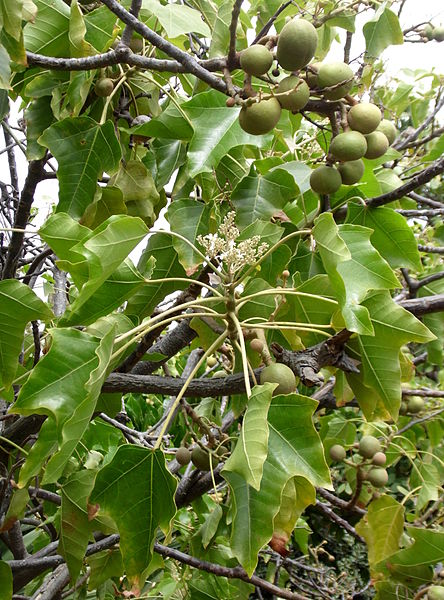New Account | Seed Mix |
Gift Certificates |AAS Winners |
Gardening Products
SEEDS: Unusual | Annuals | Perennials | Vegetables | Herbs | Trees
Candle Nut ( Aleurites moluccana ) Tree Seeds
Find your zone using Garden Web's Zone Finder

Image: By Krzysztof Ziarnek, Kenraiz [CC BY-SA 3.0], from Wikimedia Commons
RMC003 Candle Nut Tree ( Aleurites moluccana )
The Candlenut, is a flowering tree in the spurge family, Euphorbiaceae, also known as Candleberry, Indian walnut, Kemiri, Varnish tree, Nuez de la India, Buah keras or Kukui nut tree.
A medium or large sized, spreading, tropical tree up to 50-80ft tall.
Cooked nuts are generally edible, although some strains contain high amounts of cyanide. Usually the nut is pressed for its oil, which is used for a variety of industrial purposes like soap making, varnishes, and fuel.
The oil is sometimes used medicinally similar to castor oil, as well as a laxative. In Southeast Asia, the oil is sometimes applied topically to treat headaches, fevers and swollen joints.
In Ancient Hawaii, kukui nuts were burned to provide light. The nuts were strung in a row on a palm leaf midrib, lit one end, and burned one by one every 15 minutes or so. This led to their use as a measure of time. One could instruct someone to return home before the second nut burned out. Hawaiians also extracted the oil from the nut and burned it in a stone oil lamp called a kukui hele po (light, darkness goes) with a wick made of kapa cloth.
Hawaiians also had many other uses for the tree, including: leis from the shells, leaves and flowers; ink for tattoos from charred nuts; a varnish with the oil; and fishermen would chew the nuts and spit them on the water to break the surface tension and remove reflections, giving them greater underwater visibility. A red-brown dye made from the inner bark was used on kapa and aho (Touchardia latifolia cordage). A coating of kukui oil helped preserve fishing nets. The trunk was sometimes used to make smaller canoes used for fishing. Kukui was named the state tree of Hawaii on 1 May 1959 due to its multitude of uses.
In Tonga, even today, ripe nuts, named tuitui are pounded into a paste, tukilamulamu, and used as soap or shampoo. As recently as 1993, candlenuts were chewed into sweet-scented emollient utilized during a traditional funerary ritual in the outlying islands of the Kingdom of Tonga. Their scent was also used for making various sweet smelling oils for the skin.
Dead wood of candlenut is eaten by a larva of a coleoptera called Agrionome fairmairei. This larva is eaten by some people.
Modern cultivation is mostly for the oil. In plantations, each tree will produce 30-80 kg (66-180 lb) of nuts, and the nuts yield 15 to 20% of their weight in oil. Most of the oil is used locally rather than figuring in international trade.
They grow very well in tropical climates with ample rainfall, but also adapt to dry climates. Candlenut's need little if any care after they are established.
Hardiness: Candlenut trees are somewhat hardy and will survive temperatures to 25-28F.
The oil is sometimes used medicinally similar to castor oil, as well as a laxative. In Southeast Asia, the oil is sometimes applied topically to treat headaches, fevers and swollen joints.
In Ancient Hawaii, kukui nuts were burned to provide light. The nuts were strung in a row on a palm leaf midrib, lit one end, and burned one by one every 15 minutes or so. This led to their use as a measure of time. One could instruct someone to return home before the second nut burned out. Hawaiians also extracted the oil from the nut and burned it in a stone oil lamp called a kukui hele po (light, darkness goes) with a wick made of kapa cloth.
Hawaiians also had many other uses for the tree, including: leis from the shells, leaves and flowers; ink for tattoos from charred nuts; a varnish with the oil; and fishermen would chew the nuts and spit them on the water to break the surface tension and remove reflections, giving them greater underwater visibility. A red-brown dye made from the inner bark was used on kapa and aho (Touchardia latifolia cordage). A coating of kukui oil helped preserve fishing nets. The trunk was sometimes used to make smaller canoes used for fishing. Kukui was named the state tree of Hawaii on 1 May 1959 due to its multitude of uses.
In Tonga, even today, ripe nuts, named tuitui are pounded into a paste, tukilamulamu, and used as soap or shampoo. As recently as 1993, candlenuts were chewed into sweet-scented emollient utilized during a traditional funerary ritual in the outlying islands of the Kingdom of Tonga. Their scent was also used for making various sweet smelling oils for the skin.
Dead wood of candlenut is eaten by a larva of a coleoptera called Agrionome fairmairei. This larva is eaten by some people.
Modern cultivation is mostly for the oil. In plantations, each tree will produce 30-80 kg (66-180 lb) of nuts, and the nuts yield 15 to 20% of their weight in oil. Most of the oil is used locally rather than figuring in international trade.
They grow very well in tropical climates with ample rainfall, but also adapt to dry climates. Candlenut's need little if any care after they are established.
Hardiness: Candlenut trees are somewhat hardy and will survive temperatures to 25-28F.

